Nature-Inspired Outdoor STEAM Activities for Kids
STEAM is not a new concept. In fact, it is integrated into curricula throughout the US and in many other countries around the world. The internet is also full of many activities that are STEAM inspired and teach kids about the core concepts contained therein. However, the vast majority of these activities are designed to happen in the classroom. But here at Run Wild My Child, we know kids learn best when they’re outside and it’s fun. So, we are taking STEAM learning outdoors! Today, members of our Creative Team are sharing five fun and educational hands-on nature-inspired outdoor STEAM activities for kids.
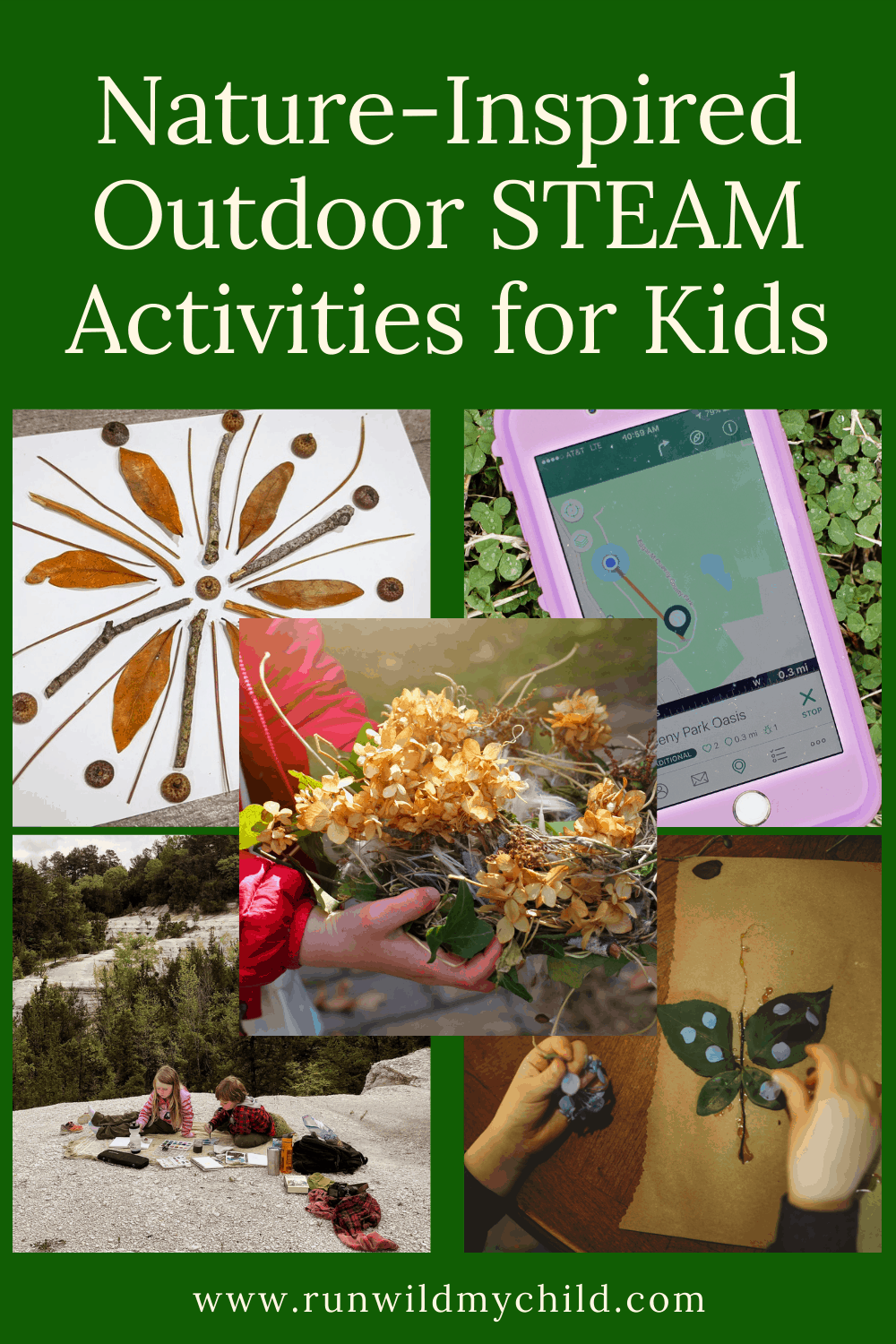
What is STEAM?
Let’s back up a bit and dive into what STEAM is. Most people are familiar with the term STEM (science, technology, engineering, and math) which was introduced into the US educational scene back in 2001. The lesser-known acronym, STEAM (science, technology, engineering, art, and math), is essentially an extension of the same idea, with the addition of art. By adding art into the mix the concept becomes more well-rounded and provides children with many more opportunities to be innovative, creative, and inventive.
In fact, Left Brain Craft Brain shared that the inclusion of art is beneficial in the following ways:
- Art helps remove idea inhibition (there’s no wrong answer in art!).
- It focuses on the process which helps drive innovation.
- Art teaches the power of observation, of people and your surroundings.
- It helps hone spatial awareness and mathematical concepts like geometry.
Combining the elements of STEAM
This method is not simply ensuring children are receiving an education that includes all of these elements. It goes much deeper than that. STEAM is rooted in the idea that these concepts should be taught together and in ways that mirror real life. This learning focuses on showing how the concepts in different subjects work together to create a whole picture.
Shelley Brewer from STEAM Powered Family said it well:
Jobs in the real world are interdisciplinary. We need to educate children in how subjects integrate and work together. They need to develop diverse skills sets and a passion for exploration and growth. We don’t need children to memorize random facts anymore. We have so many facts at our finger tips now…Instead it [education] is about learning how to think critically and evaluate information. How to apply knowledge, research and skills to problem solve.”
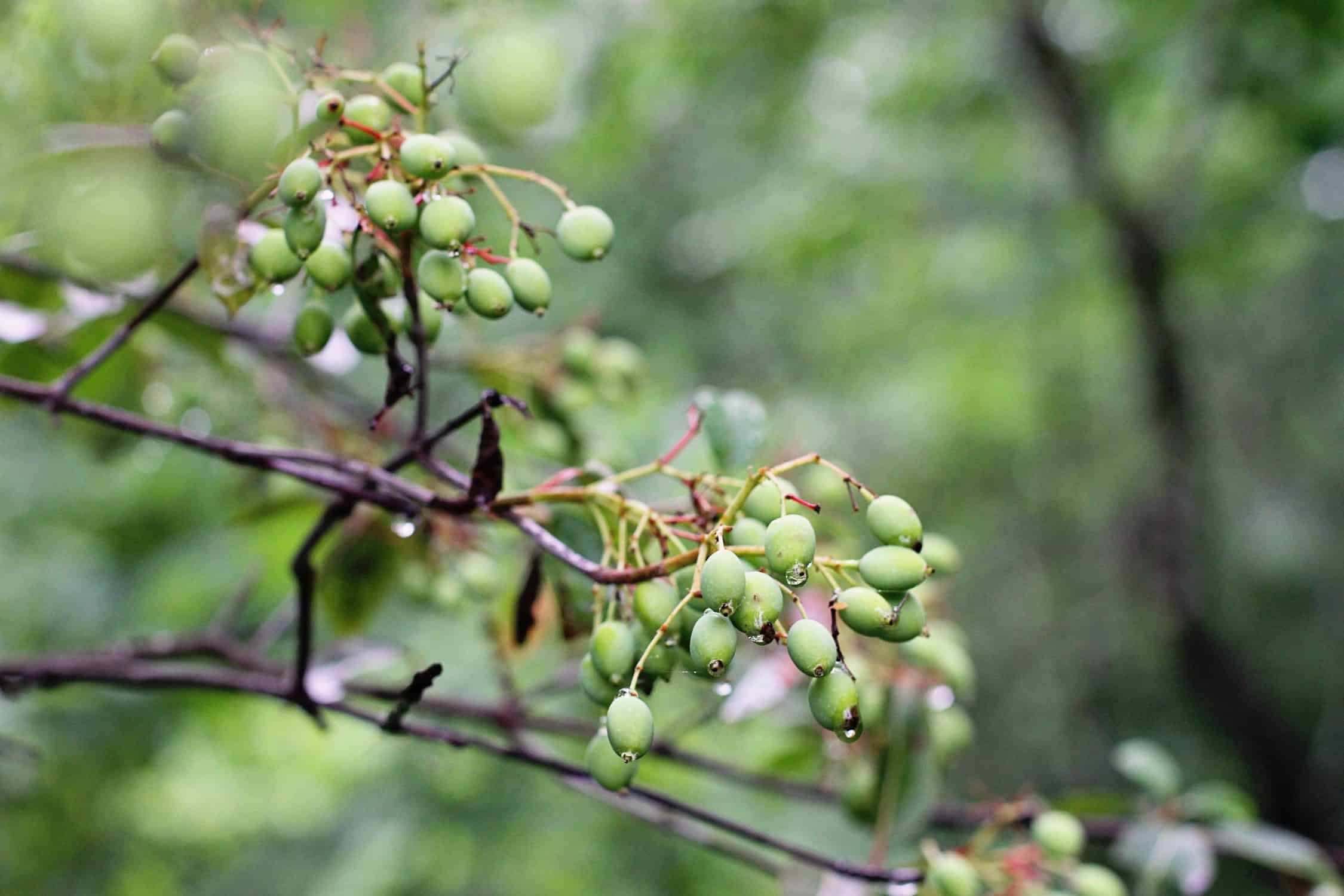
STEAM activities and nature
As we’ve seen, STEAM education is really about asking questions, exploring, observing, experimenting, and predicting what will happen. If you’ve ever seen a child engaged in play outside, then you know that all of these things come naturally to children when they are outside in nature. Nature allows children the freedom to explore and observe what interests them in the moment. Then, they can follow-up on what they discovered with questions, predictions, or experiments. This is where parents can be the most helpful. We can watch our children focus on something and then ask questions and offer activities to further engage them and provide more information.
The best part is, we don’t even need to know the information to be helpful. We can model saying, “I don’t know,” and researching the answers. In fact, we should do this. STEAM’s philosophy is founded on learning in real-world situations, and researching answers to questions.
We can also read nature-focused books to our children or watch short educational videos to take that new real-life nature discovery and add factual information in an engaging way. Children love it when something they’ve seen in real life shows up in a book or video.
This is the beauty of STEAM and nature. They are fairly open-ended and flexible in how we learn from them. There are so many ways to integrate STEAM concepts and learning into everyday nature adventures. Below are just a few ideas for nature-inspired outdoor STEAM activities that take learning outside.
Taking STEAM learning outside
To help you get started, the RWMC Creative Team put together five nature-inspired outdoor STEAM activities for kids that are easy to do and will get you outside. While we used the subjects in STEAM to break the activities up, each activity integrates two or more of the other STEAM subjects. Those are listed with each activity to help give you an idea of how easy it is for these subjects to overlap and replicate real-world projects and problem-solving.
Here are five nature-inspired outdoor STEAM activities that each focus on one element (science, technology, engineering, art, or math) and also incorporate others to create fun and unique learning experiences for kids.
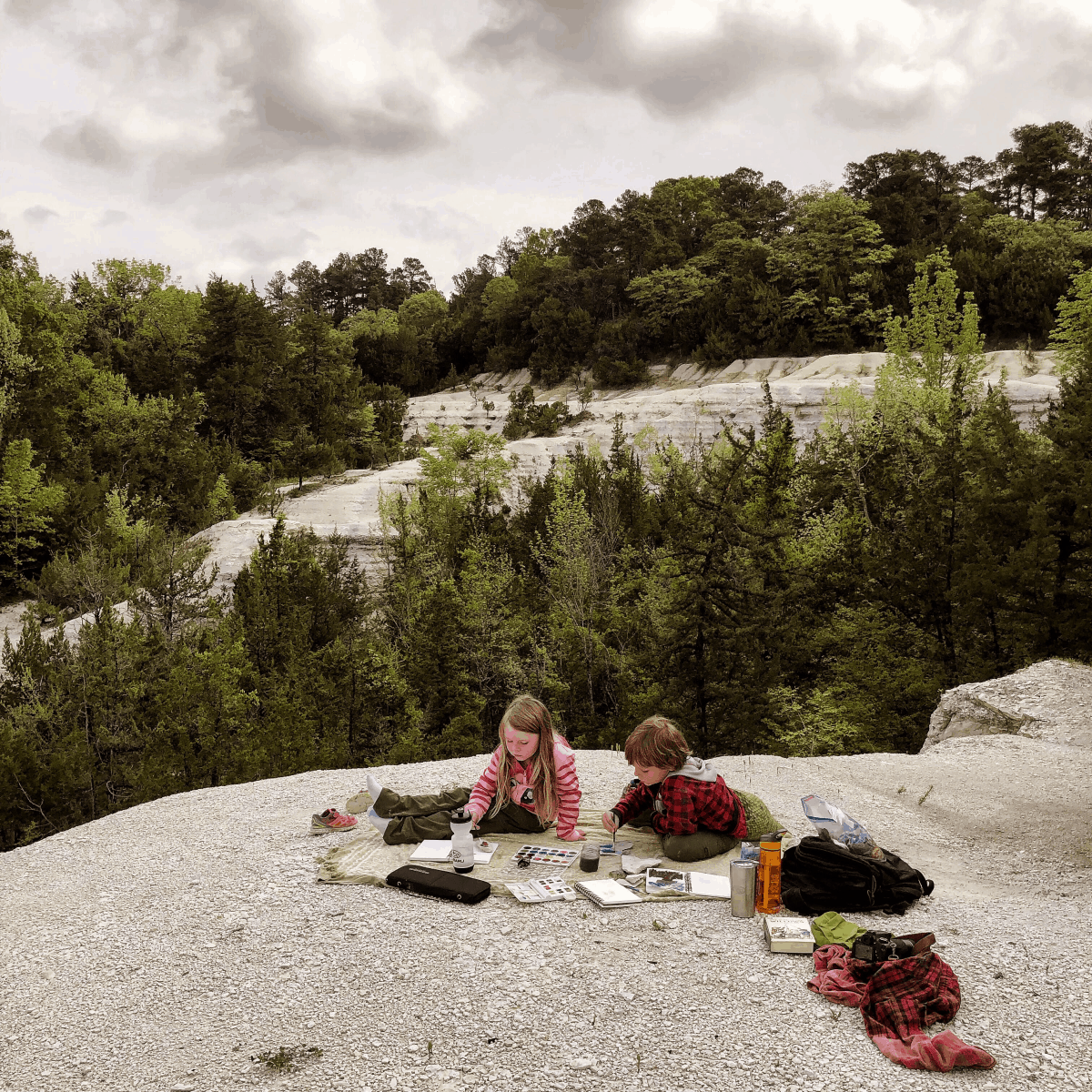
S – Science
Nichole, from Lucky Wanderers is our resident science expert. She’s here to tackle the S (science) portion of the STEAM activities. She offers a couple different ideas on how to incorporate science into studying nature with children.
Science has always been near and dear to my heart. It’s the lens through which most of our homeschool studies pass through. The really amazing thing about science is that there are so many ways to study it! When my kids were very little, the easiest way to begin science studies was nature study. Nature study is preliminary botany and biology and a bit of animal sciences. It’s the process of noticing and learning the world around you, sometimes even right in your own backyard!
“We are all meant to be naturalists, each in his own degree, and it is inexcusable to live in a world so full of the marvels of plant and animal life and to care for none of these things.” – Charlotte Mason.
Nature study and journaling
Our nature study began with birds. We started by putting up a few bird feeders in our back yard, placed our bird guides right in our window and started a journal to keep track of what we saw. Each morning at breakfast we would throw open our window shades and be delighted at spotting Red Bellied Woodpeckers, Carolina Wrens, and even a few House Finches. My children were little so their journals were actually full of little drawings of what they saw. As they have grown, their drawings have become more detailed. We still keep track of what we see out that window. We studied migration patterns, bird habitats, and learned about the importance of providing native plants for our bird population.
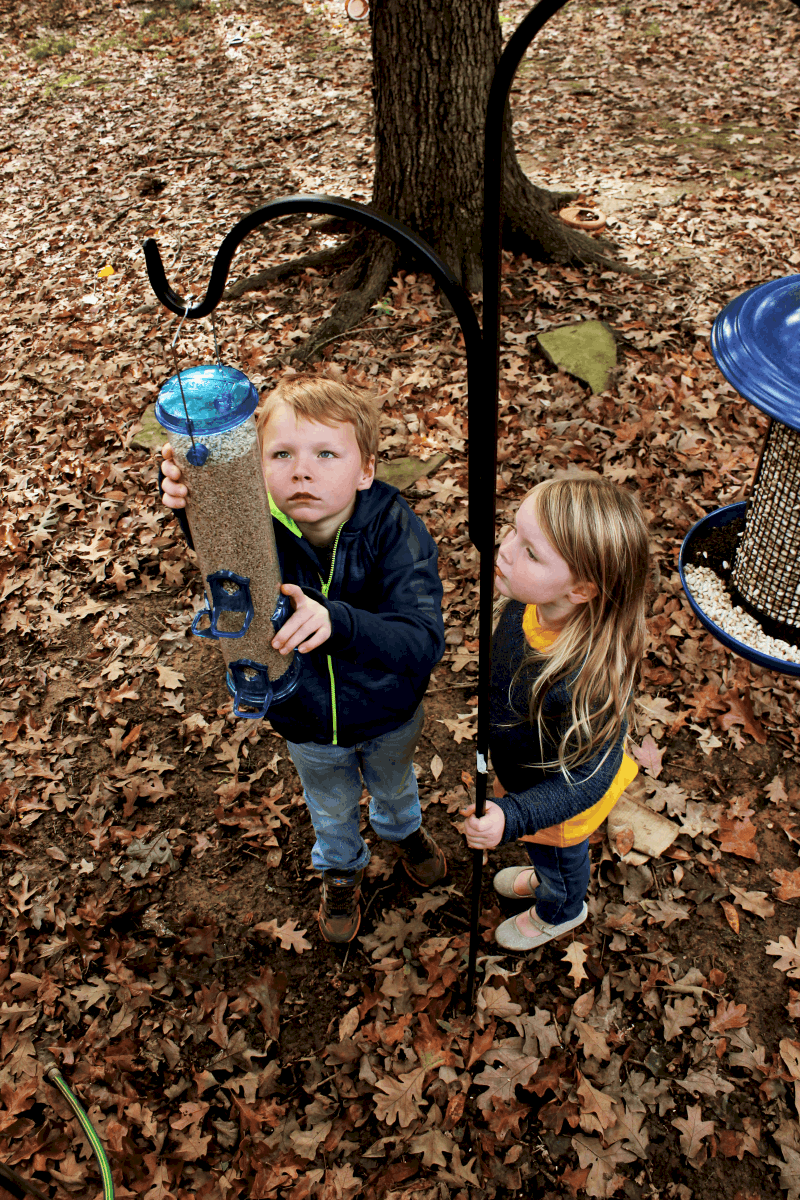
The process of nature journaling begins simply, as a way to help stimulate observation in your children, but as they age you can dive deeper into the studies. Once we found a Polyphemus Moth in our backyard, which led us to journal it, labeling the beautiful eye spots, antenna, and other body parts. Curiosity then took us on a side study to figure out what it eats and why it was in our yard, along with the life cycle.
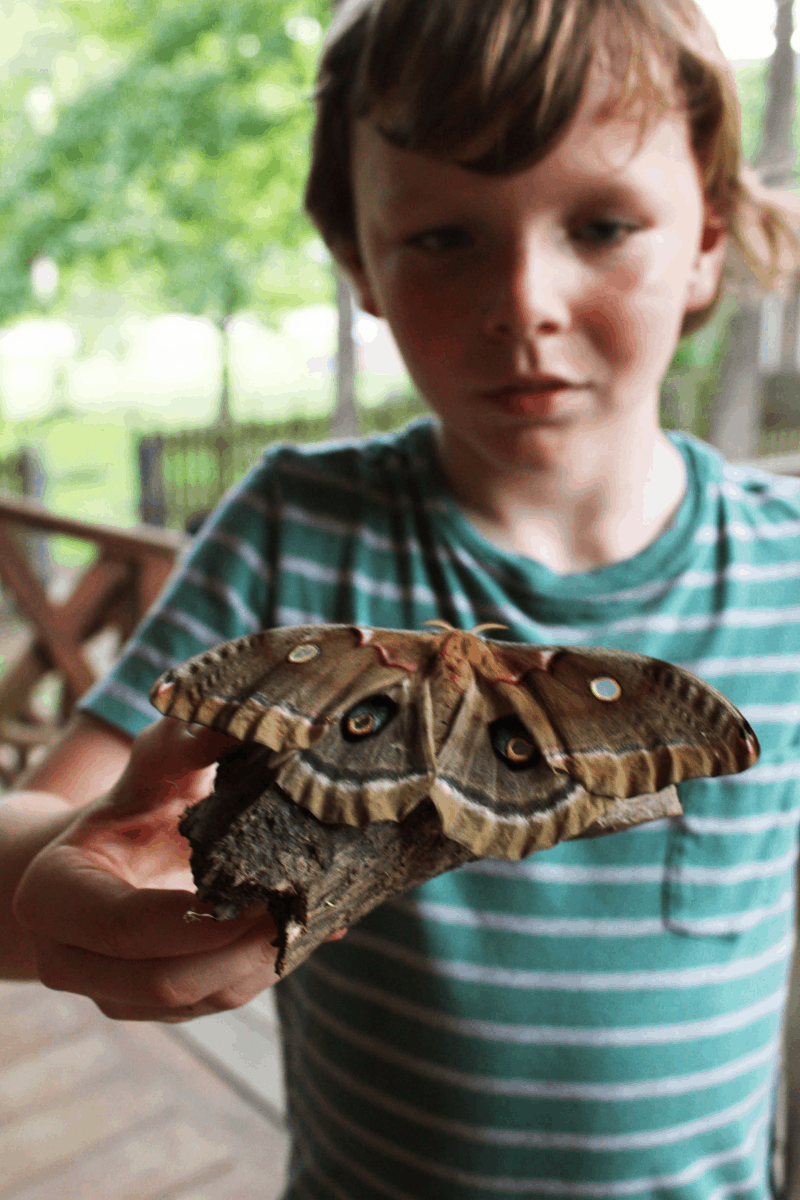
Over the years we’ve collected a nice pile of journals, filled with progressively more detailed drawings, of things my children have spotted on our adventures. When we get home, we pull out all of our nature guides, learning in detail about what we spotted. The journaling process makes it stick. Along with that they are working on their penmanship and sharpening their art skills. Nature journaling in of itself becomes a beautiful mixing of art and science, and you can be as detailed or as minimal as you want. There are no rules. John Muir Laws makes a wonderful book that can help get you started with nature journaling.
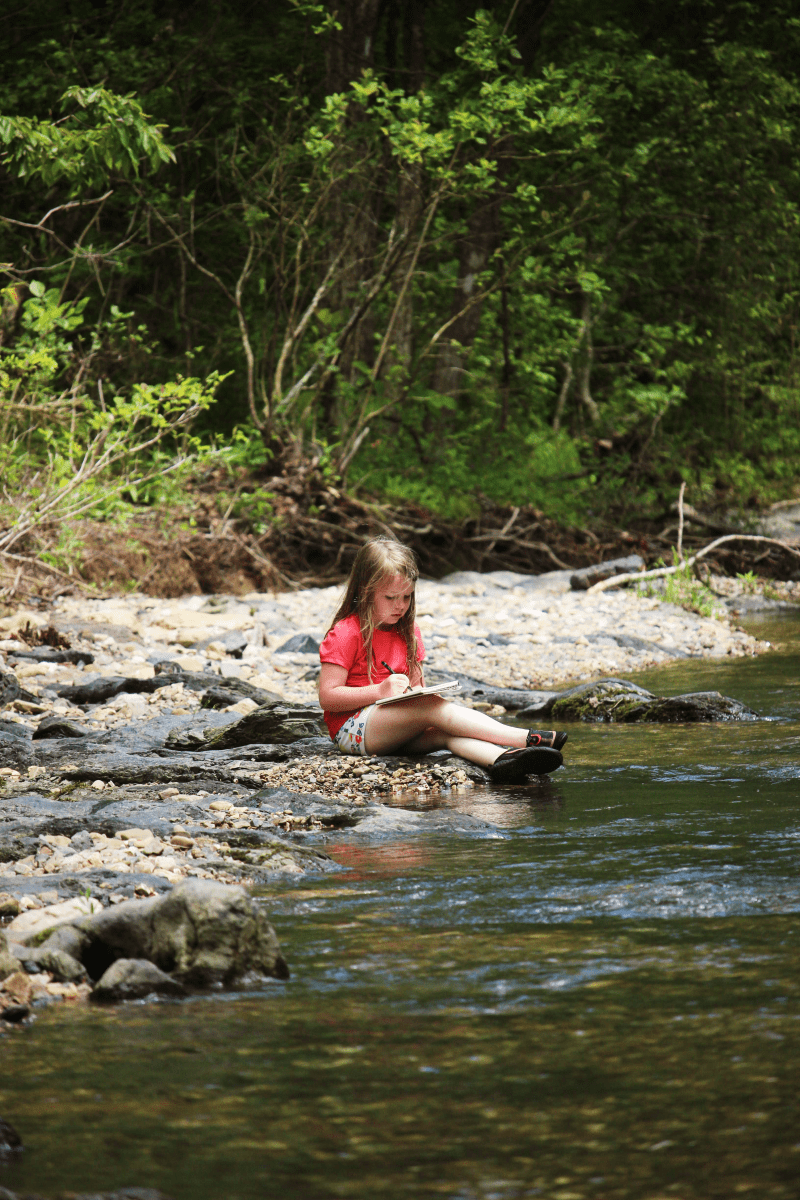
Technology also walks hand in hand with our science studies. We often use the Seek by iNaturalist app to identify things we do not know, while out adventuring. (More on this app below.)
Recently, we took our nature journaling to the microbial level. My kids were curious about soil and my microbiology loving heart couldn’t hold back my excitement. We learned how to make a soil suspension, I taught my children how to make a wet mount slide, and then stepped back and waited for the excited shouts when they discovered a nematode wiggling across the viewfinder. Through that experiment, we were able to take a look at our soil health, and maybe improve it. Which leads to a healthier garden and more botany studies.
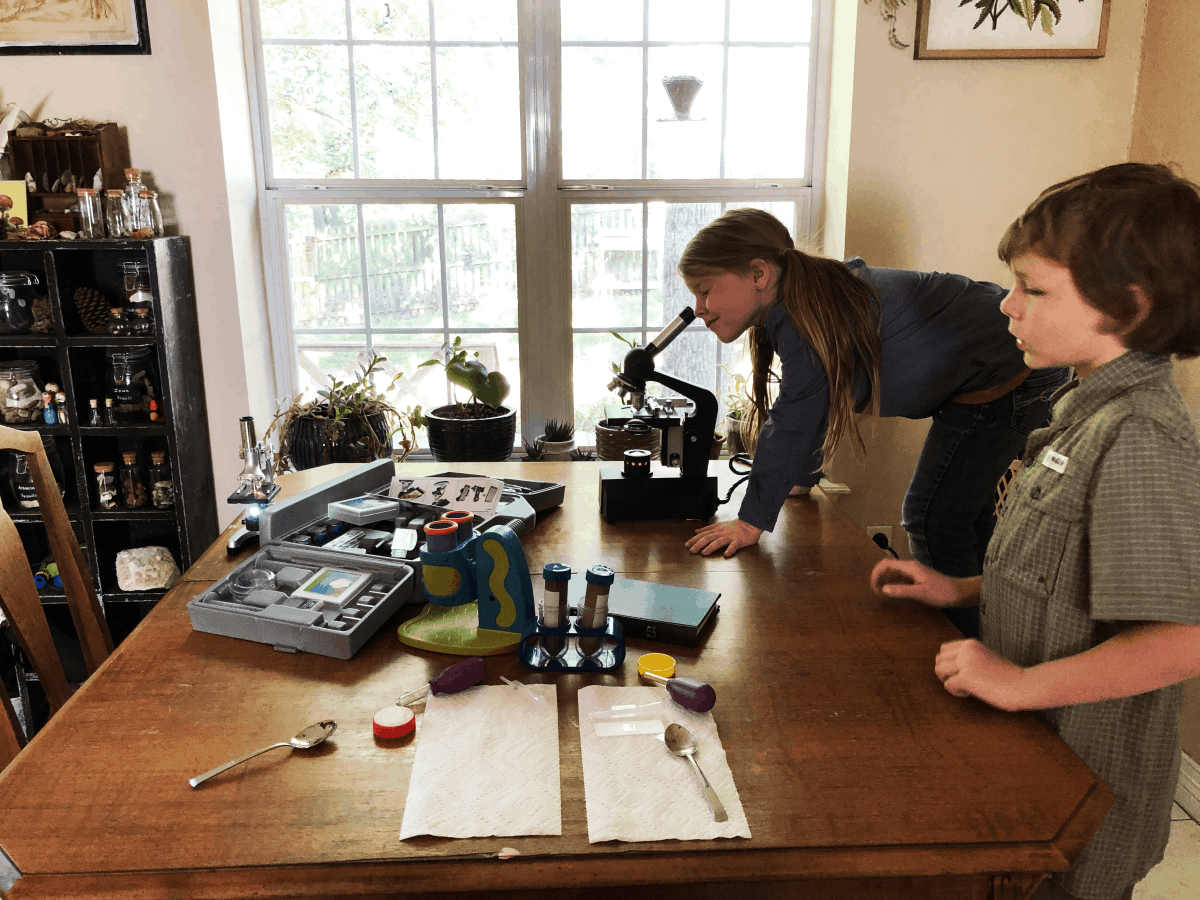
It’s all about perspective and when you learn to look at the world around you with constant curiosity, you will see the interconnectedness of all the disciplines.
Primary STEAM subject: Science
Integrated STEAM subjects: Art and technology
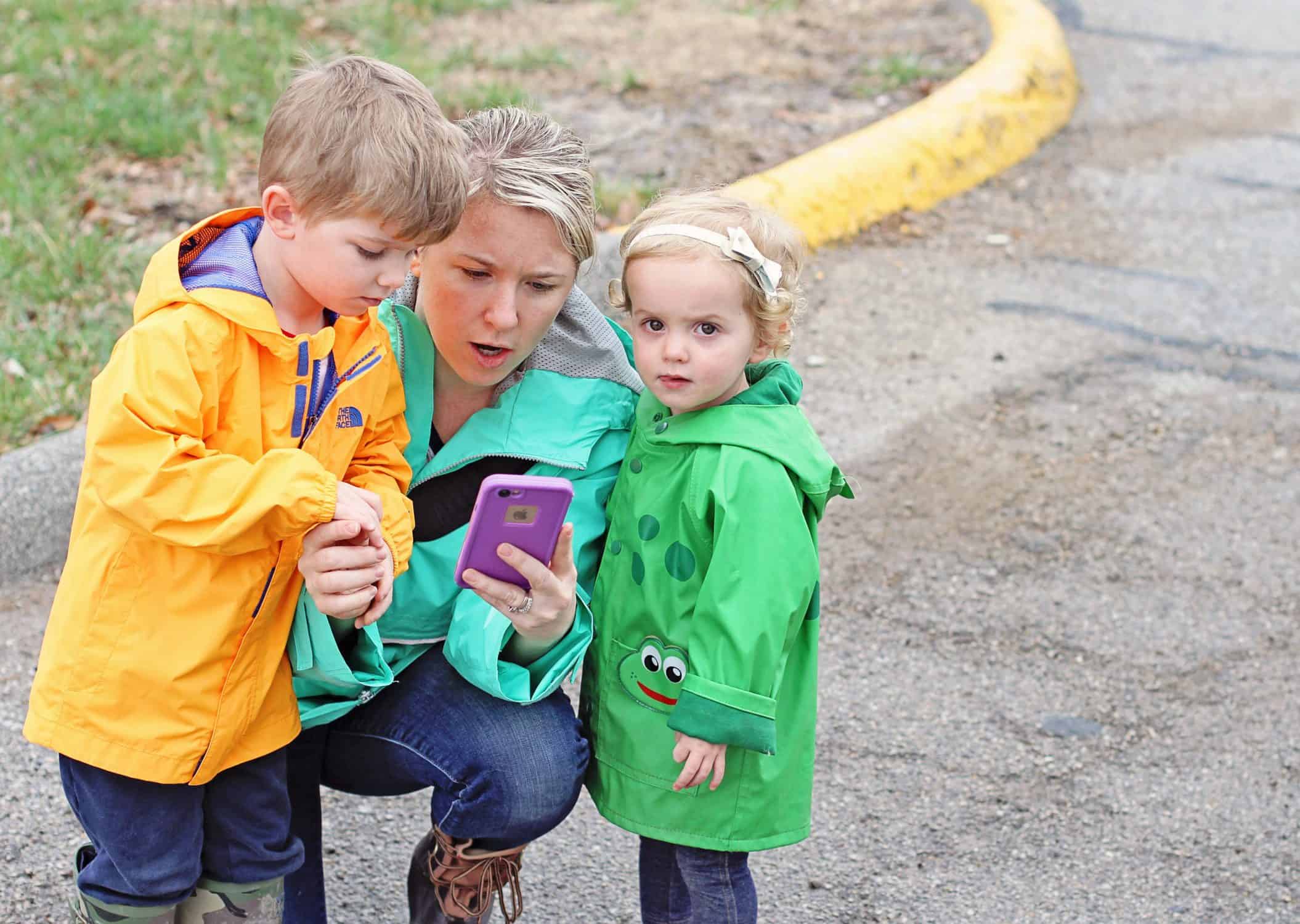
T – Technology
Technology is everywhere these days and kids love all things tech! This generation has grown up hand-in-hand with technology and kids today are very adept at technology. While we certainly don’t want your child spending a lot of time in front of a screen, we know that technology is an important part of the world our children and growing up in.
And not all screens are bad and technology certainly isn’t the enemy. We think balance is important in all aspects of life and kids need to learn about technology, in addition to spending time outside in nature. There are lots of ways that technology makes it fun and easy to get outside and learn.
Today, to tackle the technology portion of STEAM, we’ll explore four different apps that kids (and parents) can use to get outside, learn about the world around them, and have fun! Each of these apps is a new and creative way to combine technology with getting out of the house and makes it fun for kids. The apps are used during outdoor activities such as hiking, stargazing, and general exploring. Best of all, they’re completely FREE!
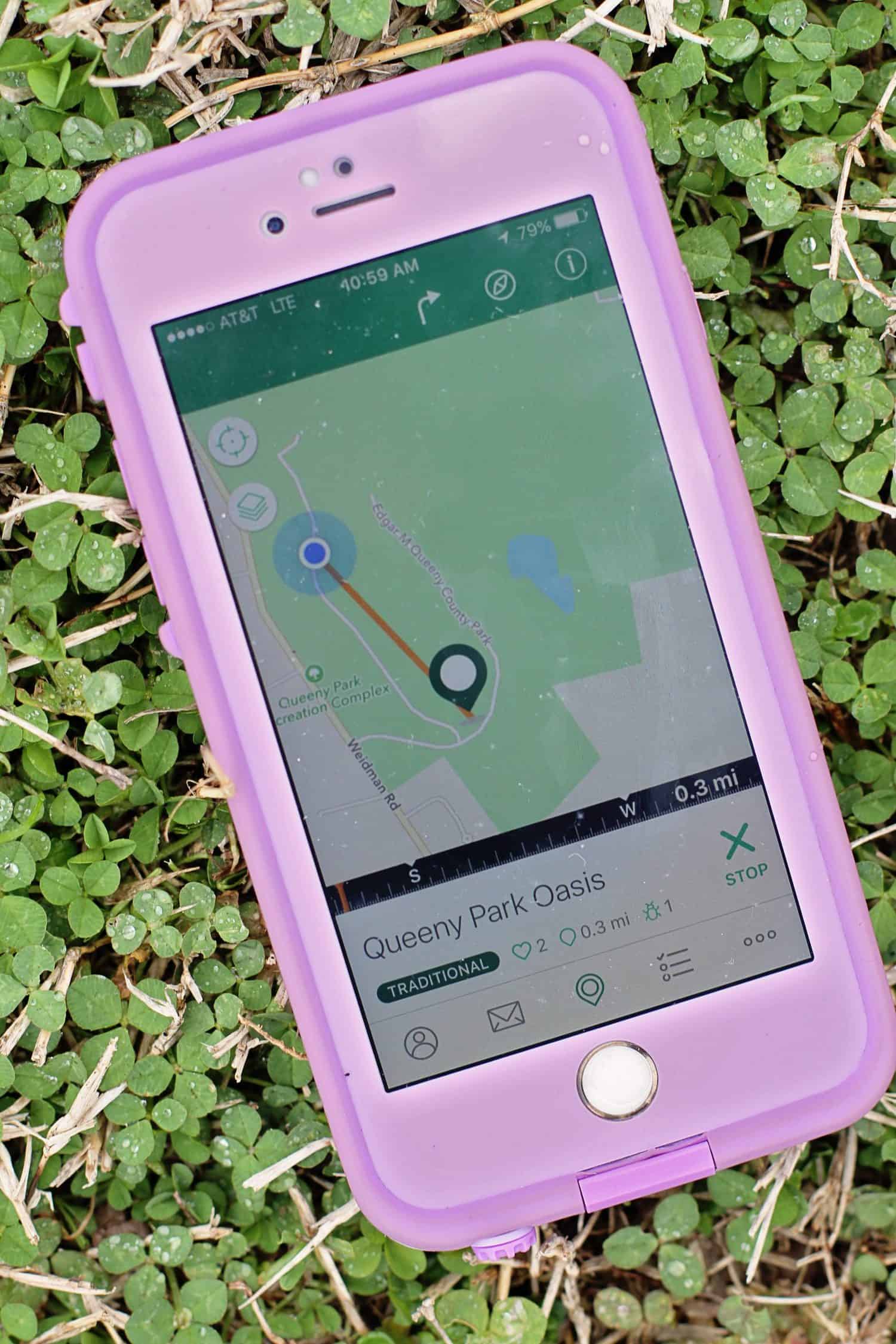
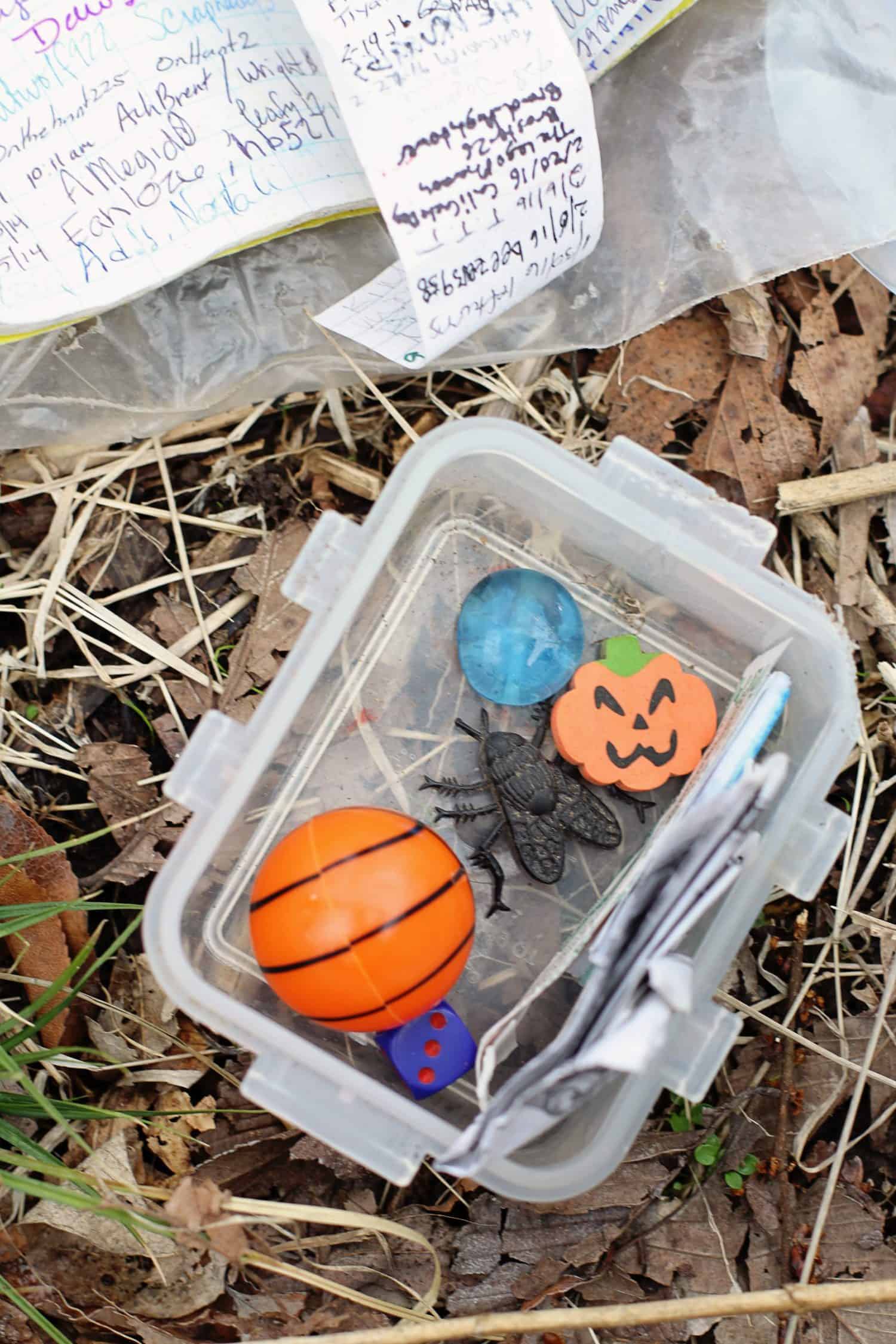
Using apps for outdoor learning and exploration
Geocaching – Geocaching (pronounced GEE-o-cash-ing) is a real-world, outdoor treasure hunt and it’s so much fun for kids and families. Using a free app on your phone, you pull up your geocaching map, choose a cache near you, navigate to a specific set of coordinates and then attempt to find a geocache (container) hidden at that location. Geocaches can be found all over the world and almost anywhere you can imagine! Our family is obsessed with geocaching and we love finding “treasure” anytime we’re out at the park, in the city, or hiking.
SkyView – To help your child learn astronomy through stargazing, there are some really great technology tools, including the SkyView Lite free app. The SkyView star finder app can help your child find and identify constellations using your phone’s camera. You child can use this app to find her favorite constellations as they fade in and out while scanning across the sky, locate the Moon, discover distant galaxies, and witness satellite fly-bys.
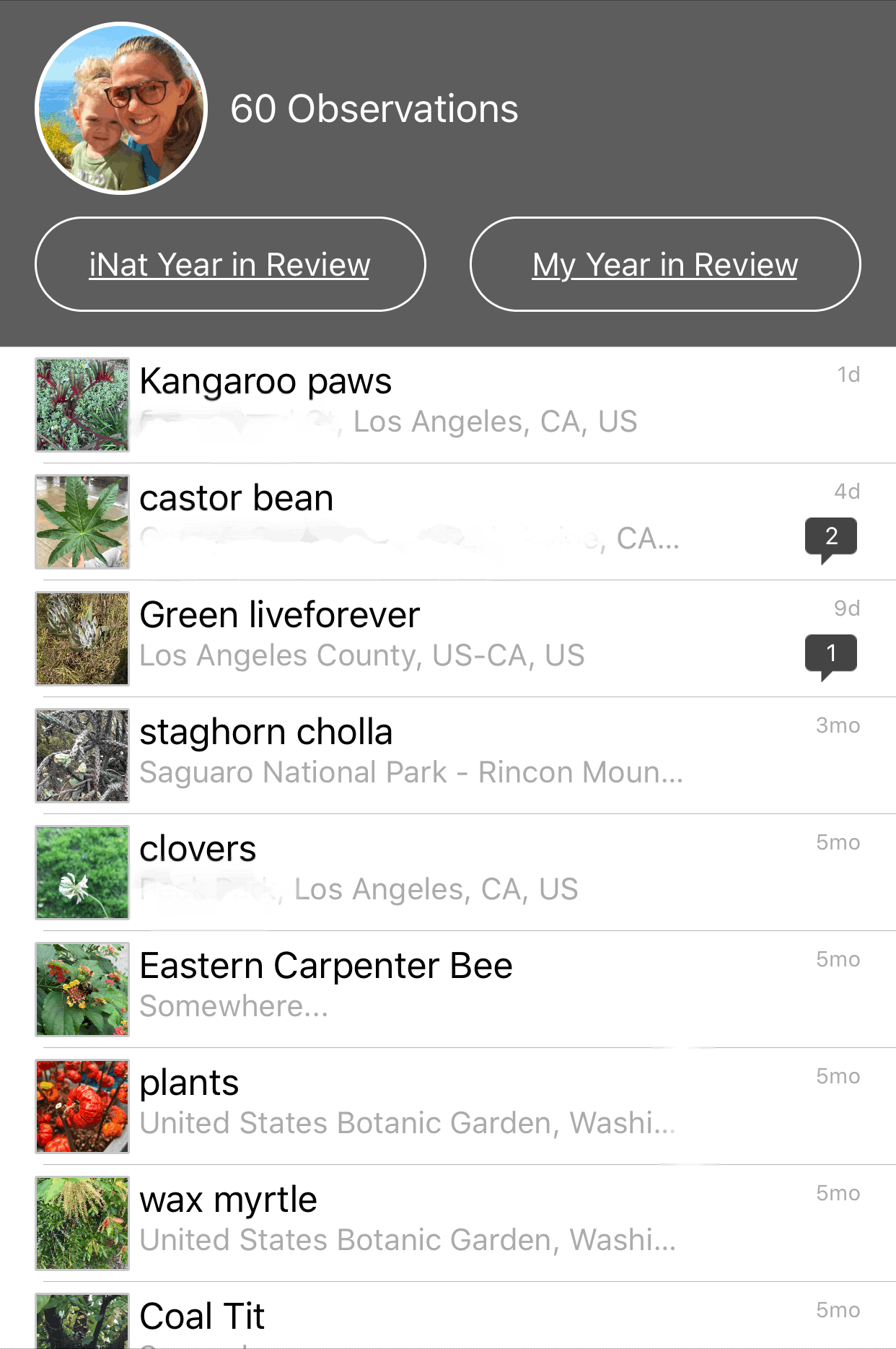
Seek by iNaturalist – Seek by iNaturalist is a really great app that can be used to identify plants, flowers, fungus, and more in your area. This app is great because it can be used anywhere, is completely free, and incredibly educational. Anytime we’re out exploring, hiking, or camping and come across an unfamiliar plant, we can open the app, snap a quick photo, tag our location, and try to figure out exactly what the plant is. It usually gives us suggestions and we use our observation and deduction skills to identify the plant. Plus, we can learn all kinds of interesting facts about it and document our adventure!
Alltrails -The Alltrails app boasts that “the beauty of nature doesn’t need to be hard to find.” This free and simple app holds the largest online collection of hand-curated trail guides, so you can hike and explore the outdoors with confidence. Anytime and anywhere. It’s easy for kids to use, helps teach them about reading maps, terrain, and elevation. Plus, users leave lots of helpful feedback on trails about whether the trail is kid-friendly, where to park, what to expect, and other useful info.
Primary STEAM subject: Technology
Integrated STEAM subjects: Science (geography, astronomy)
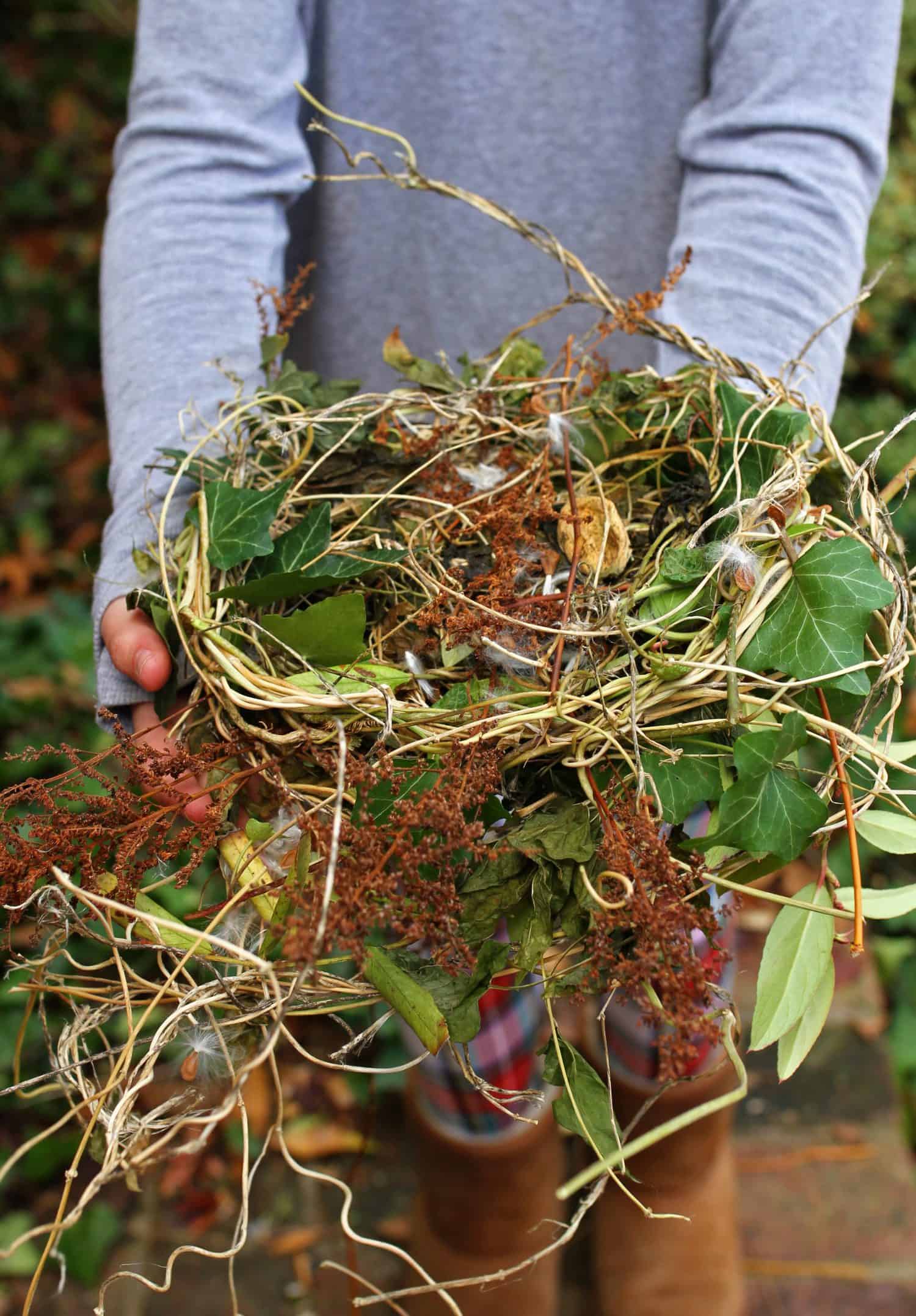
E – Engineering
Engineering is the ability to apply scientific knowledge to solve real-world problems. Engineering is the practical application of more abstract sciences like chemistry and physics. Kids can use engineering to solve a variety of problems, from figuring out how to stack rocks or blocks without them falling, to building simple machines (like pulleys) to determining the best tool to use for a project.
Engineering challenges teach so many things to kids, such as critical thinking, problem-solving, teamwork, and how materials behave in different situations. Even the youngest kids can use engineering for hands-on, educational fun.
We love using natural items found outside to take our engineering challenges to the next level. Not all our projects turn out well (I’m particularly thinking of a “build a boat out of leaves” project we tried a few years ago that immediately sunk resulting in lots of tears). But sometimes the best projects are the tough ones, because they teach kids how to fail without giving up, how things work (and don’t), and practical problem-solving skills.
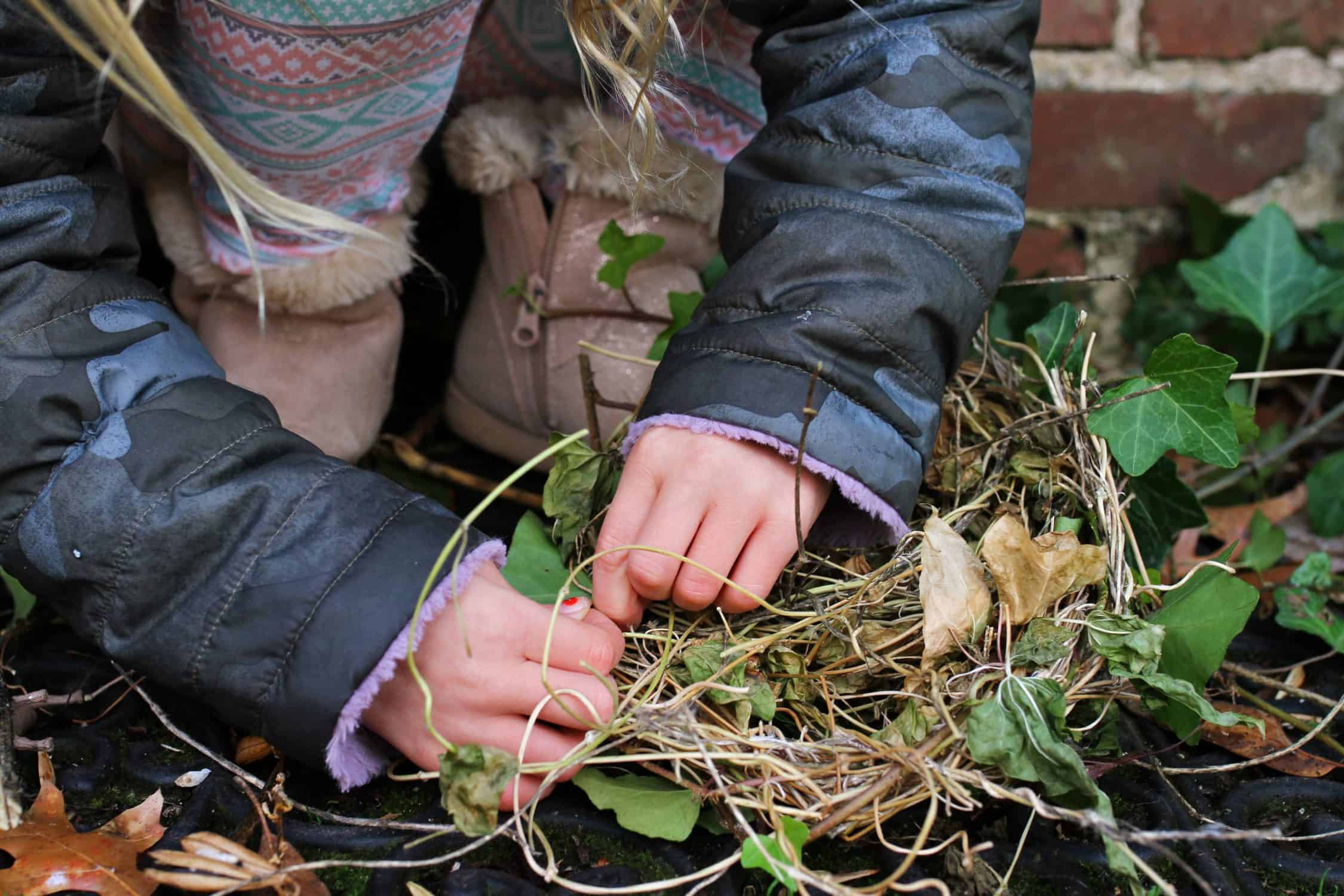
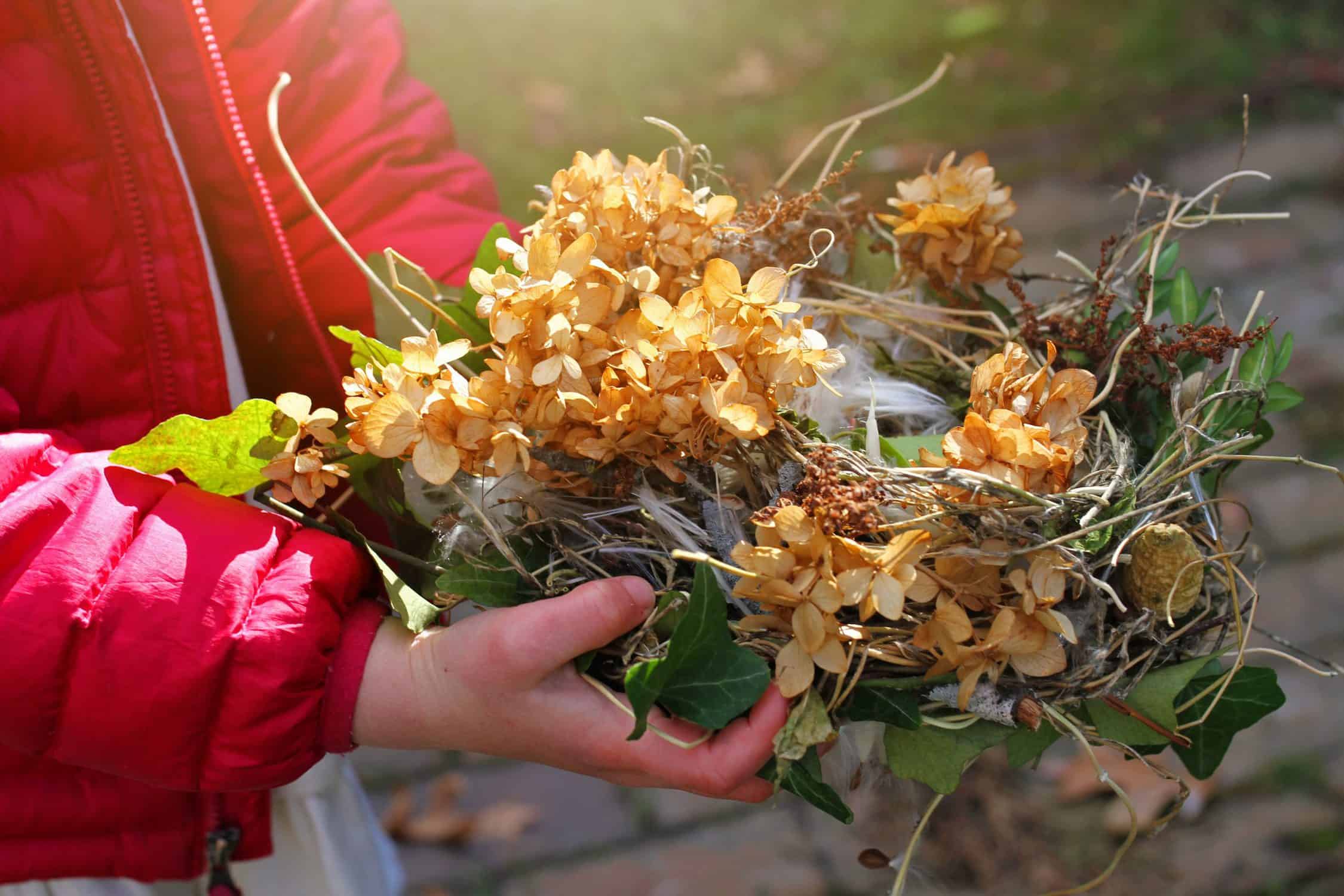
Engineering a bird’s nest
To cover the E for Engineering portion of our outdoor STEAM activities, Sara McCarty and her family tried their hands at building a simple bird’s nest out of natural materials they found around their neighborhood. Here’s what she had to say:
We started by collecting items that a local bird could find in our yard (no string, no glue). The kids loved foraging for materials and collected sticks, ivy, flowers, leaves, branches, and milkweed vines and seed pods.
Once we’d collected our materials, it was time to begin the process. We brainstormed different ways to form the structure of the nest. There were quite a few failed attempts before we figured things out. Trial and error led us to eventually using the ivy to form a circle and starting from there. Quite often we remarked on how extraordinary birds were because they could build strong beautiful nests without hands!
When the outline of the nest was ready, we used the milkweed vines to form the center and the bottom. Wrapping them around your hand created a circular nest-like shape, which the kids inserted into their ivy structure. We used sticks and twigs to support the nest and give it a little extra stability.
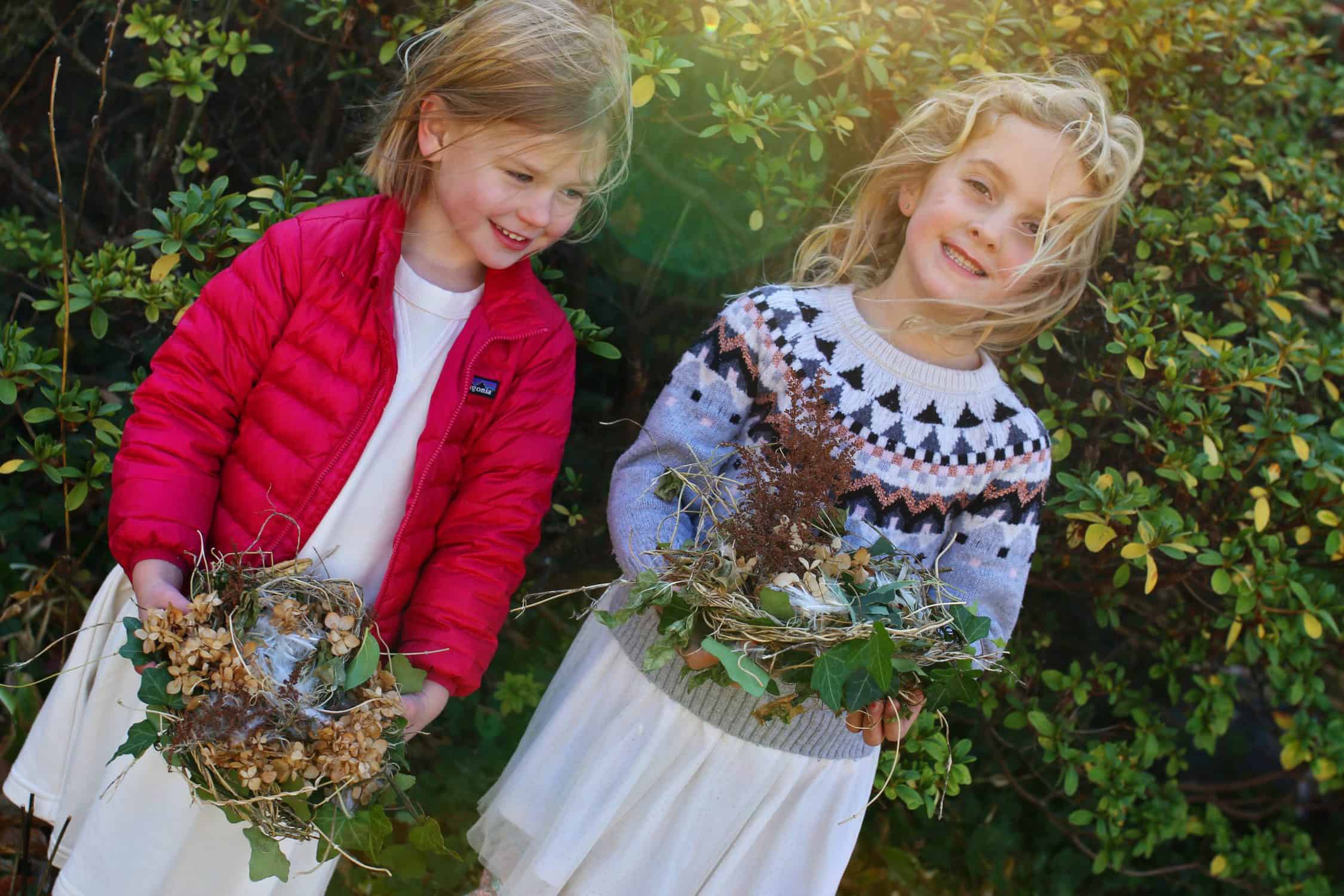
The final step was decorating the nest (adding a little ART to our ENGINEERING). I think the girls had the most fun with this part. They added flowers they found and pretty leaves. They broke open the milkweed pods and pulled out the fluffy seeds to create a nice soft warm bed for the birds. The kids took so much pleasure in making the nests beautiful and I was shocked at how pretty the nests ended up being.
Making the bird nests was so much fun! Honestly, it was a little harder than I expected it to be and I was worried that they wouldn’t turn out. However, I was blown away at how resourceful and creative the kids were. They never gave up. They kept trying. Even when the nests fell apart, they didn’t get frustrated or angry. When something didn’t work, they tried something else. They helped each other. It was an amazing experience for me to watch as a parent and I think both me and the kids learned something valuable.
Primary STEAM subject: Engineering
Integrated STEAM subjects: Art
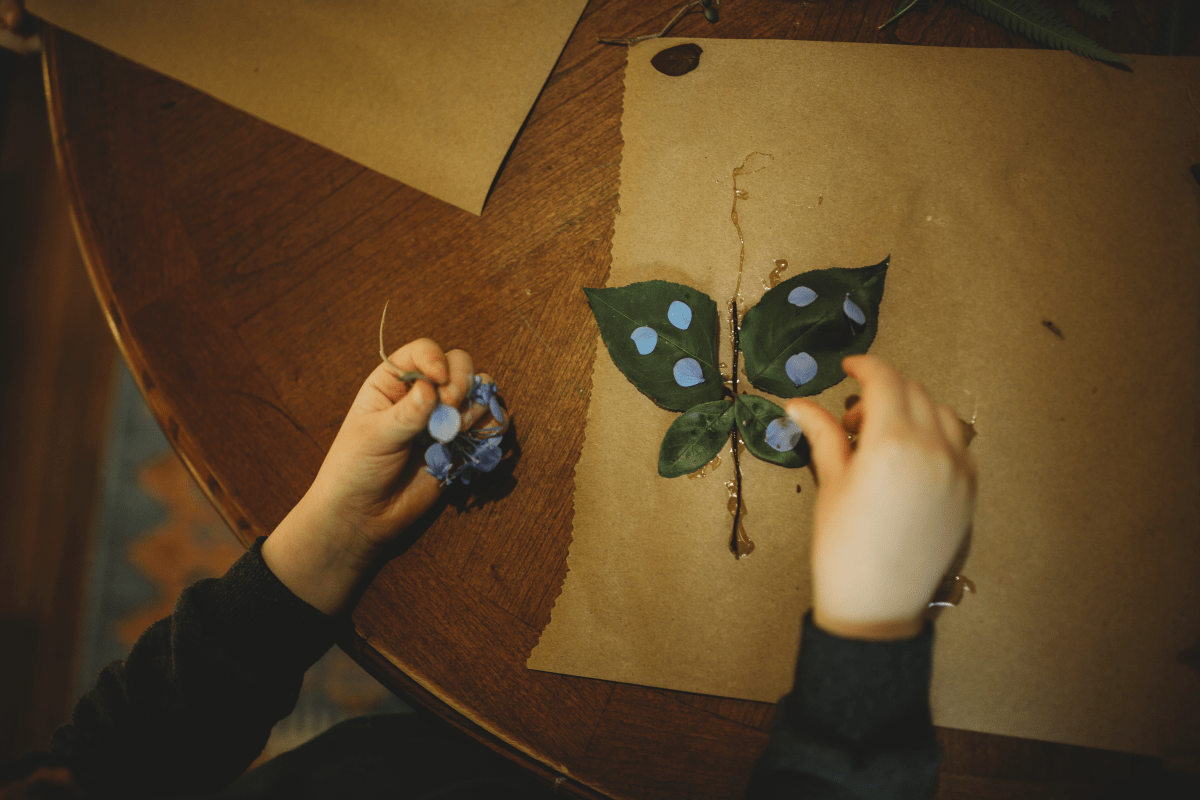
A – Art
We’ve already talked a bit about the benefits of adding art into STEAM activities. Art is a universal form of expression, as elemental as speaking or singing. Kids are naturally drawn to art and love creating. Everyone can make art – even those without artistic talent or training. Art is a way for kids to express themselves and show their creativity and imagination. Art is an essential part of the human experience.
Being outdoors and in nature is the perfect place to observe and appreciate art. Nature is beautiful and kids can find a lot of inspiration by looking at leaves, flowers, plants, and trees. And just as kids can quickly pick up stories or songs, they can easily turn their outdoor observations of nature and the world around them into art. There really is no comparison when using your treasured nature finds to create works of art!
Foraged Animal Art
Filling you in on the A in STEAM with beautiful art made with foraged nature treasures is Tiffany, of @dear.wildlings. Tiffany and her kids foraged for items in nature and used them to create beautiful works of nature art by creating animals. Here’s Tiffany with more…
This easy and fun STEAM craft allows children to focus on their observation skills to pay attention to detail. It also utilizes fine motor skills to create nature scenes and animals. This is great for kids of all ages and doesn’t take a lot of pre-planning or work to do.
While technically an ART project, you can easily incorporate a few other STEAM concepts to make it even more educational and fun for the kids. Add some science by discussing and learning about the kind of plants around your yard. Study and research the animals you want to try to recreate with your finds. Look them up in a book or online and learn about what they eat and where they live. Count the plants you collect, or how many you’re gluing on to your board with your children to incorporate more math into this activity.
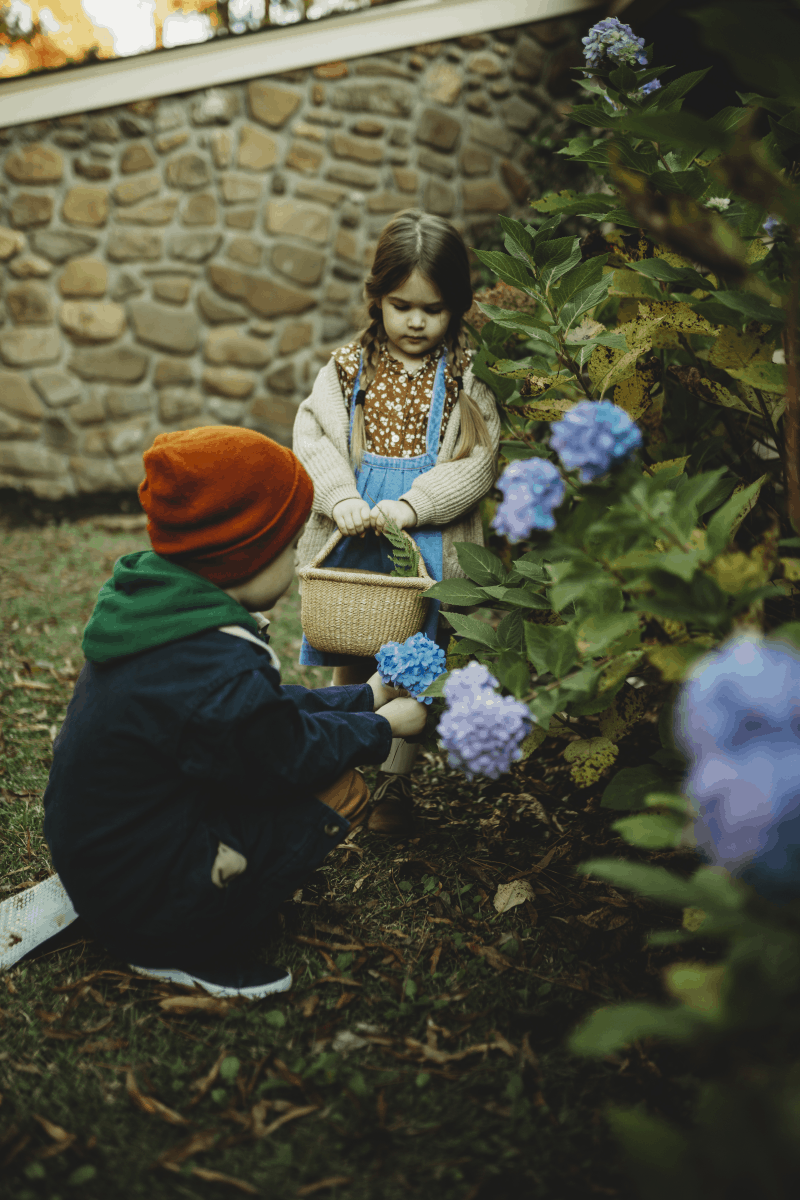
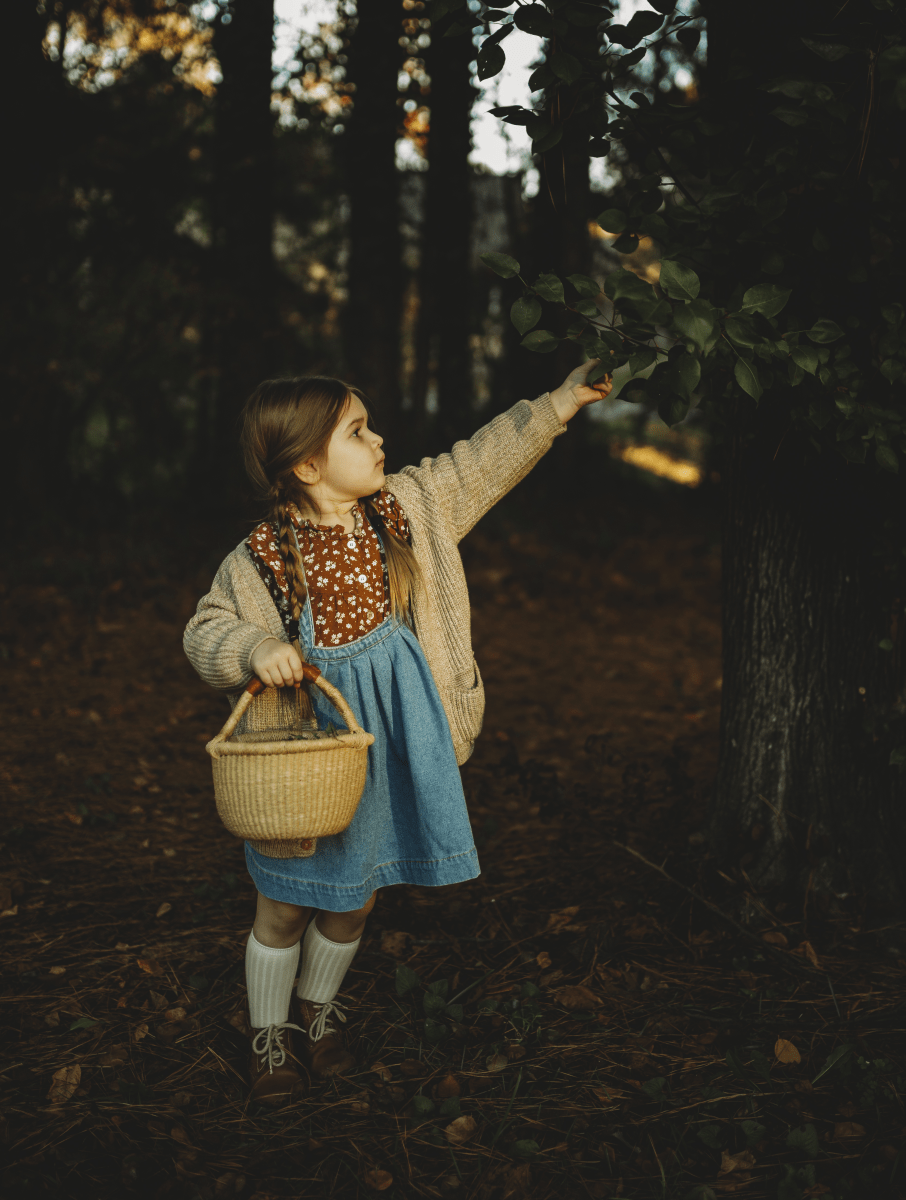
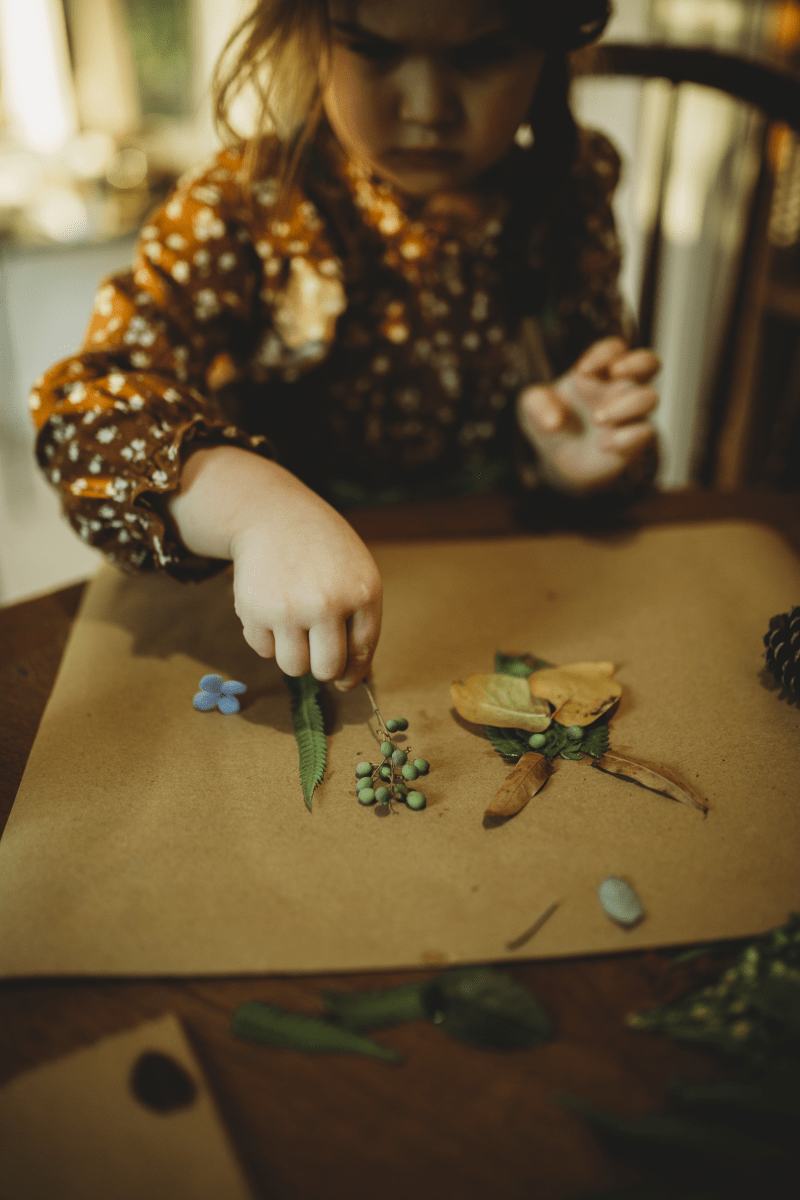
For this activity, you will need:
- cardboard
- glue
- a collection basket
- some beautiful nature finds
What to do:
- Go for a nature walk around your yard or your favorite local spot. Get outside, explore, and enjoy the fresh air.
- Collect leaves, branches, berries, flowers, etc. The more variety, the better!
- Glue all your nature goodies to cardboard to create animals of your choice. Let your imagination run wild!
Primary STEAM subject: Art
Integrated STEAM subjects: Science (biology)
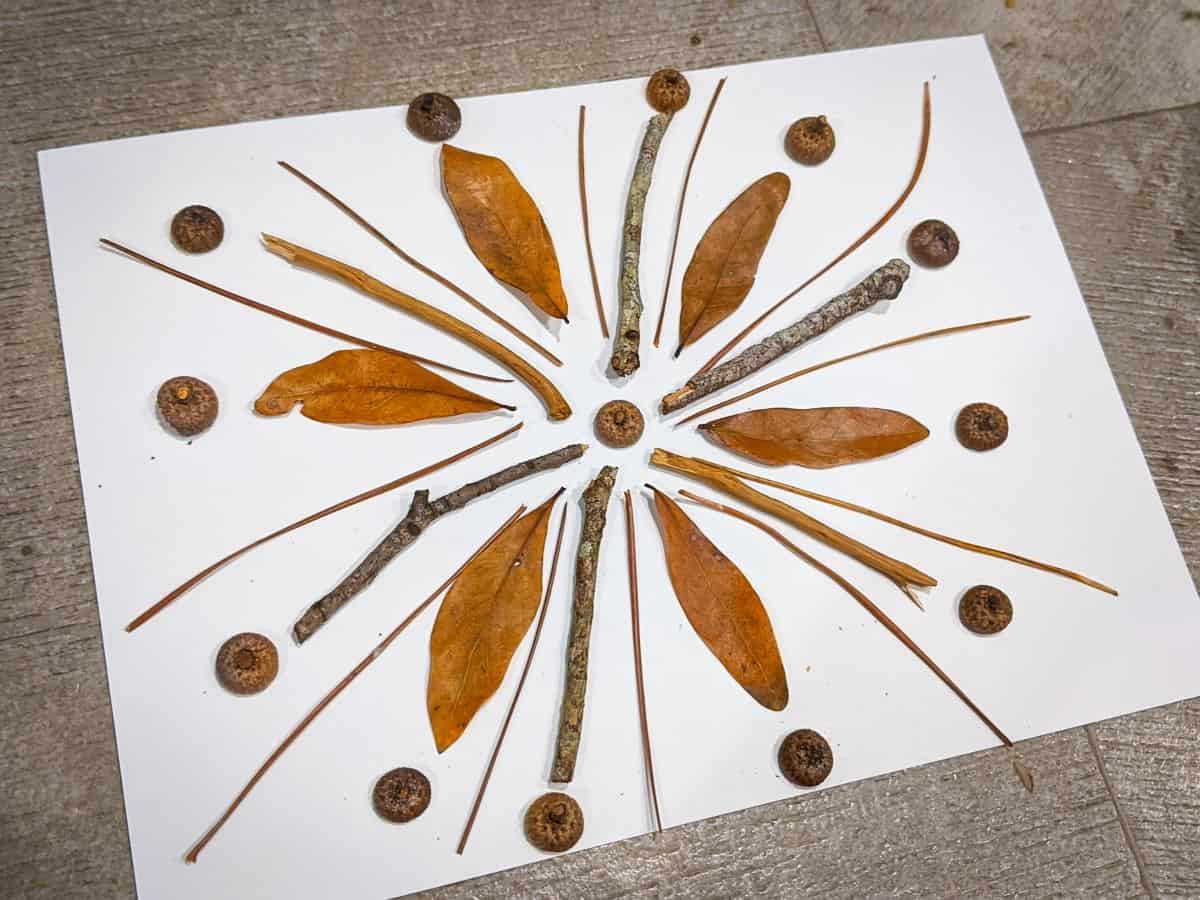
M – Math
Nature and math go hand in hand so easily. With young kids, you can count acorns, pinecones, trees, rocks, leaves, and so much more. Once children enter elementary school, you can collect these same objects (or any others) and use them as math manipulables. Believe it or not, the majority (if not all) of elementary school math can be taught using nature. Check out Wild Math Curriculum to learn more.
We love integrating nature into our learning, and for us
Nature snowflakes
Since winter is right around the corner and snowflakes capture the imagination of children everywhere, Katie Fox, of Family in Wanderland, is bringing you a Nature Snowflakes outdoor STEAM activity that reinforces the concepts of symmetry and patterns.
Since we travel in an RV full-time, holiday decorations tend to be primarily the art we create and are almost always inspired by or contain pieces of nature. So, creating nature snowflakes to hang up for the holidays and provide us with a little snow, since our planned winter route taking us nowhere near actual snow, was an easy choice. Plus, the activity helps emphasize patterns, which is something we’ve been learning this year.
For this outdoor STEAM activity you really only need some nature items and a place to create your snowflakes. This can be the ground outside, a table, or even somewhere indoors if the weather isn’t ideal for outdoor activities. If you wish you keep them and use them as decorations for the holidays or give them away as gifts, you can glue them to thick paper/cardstock.
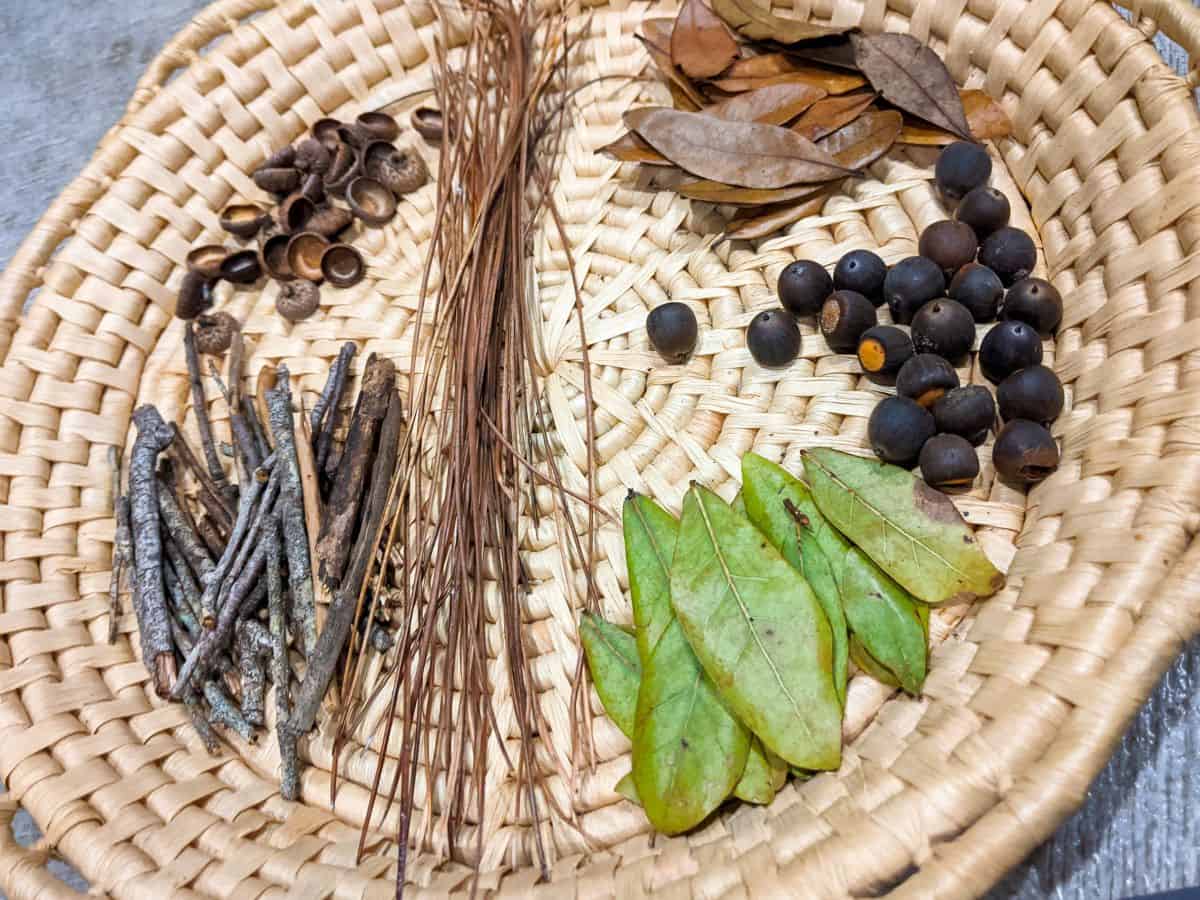
The first part of the activity was gathering the nature pieces. I explained to my children that we needed a lot of each item and that we wanted each item to be about the same size. We gathered sticks, pine needles, acorn tops, fallen leaves, and acorns. I broke the sticks apart to make them about the same length, but my five-year-old was a champion at finding sticks that were very similar in thickness and leaves that were about the same size.
My children insisted that snowflakes are white, so I brought out our white paint and we all spent a lot of time painting each snowflake piece. This is obviously not necessary, but was an impromptu addition to our activity.
Painting took up the majority of our time, so if you do not do that, this activity can be done really quickly. This was the three-year-old’s favorite part and he was a champ at painting the leaves.
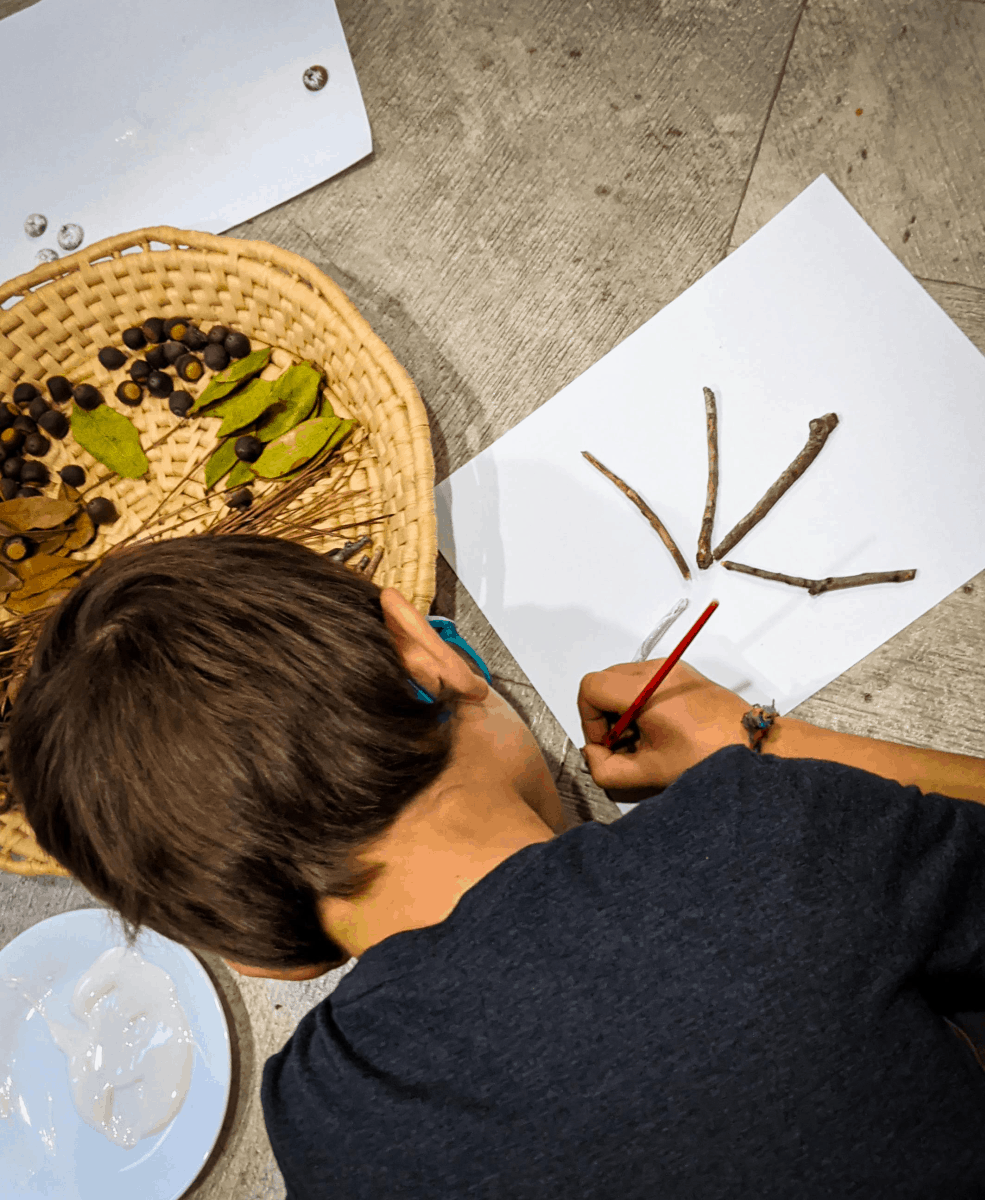
The next step is to arrange the nature pieces into symmetrical designs. I made one as an example of what symmetry looks like, and then took it apart. Next I helped my kids out when needed, but gave them the space to try, ask questions, and even fail.
My five-year-old figured out how to create a pattern and make his snowflake look uniform. But, at first he struggled with spacing and consistency in design. I asked him questions like, “do you think your snowflake is symmetrical?” and “how could you get your snowflake to look the same on each side?” The three-year-old needed a little more help, but did pick the objects he wanted to use and helped lay all the pieces down into a pattern.
There are so many ways these same nature objects could be used to create unique and beautiful snowflakes. I honestly had a lot of fun too, so I am pretty sure this activity would be a hit with older children and teens as well. There’s only one way to find out. Give it a try!
Primary STEAM subject: Math
Integrated STEAM subjects: Art
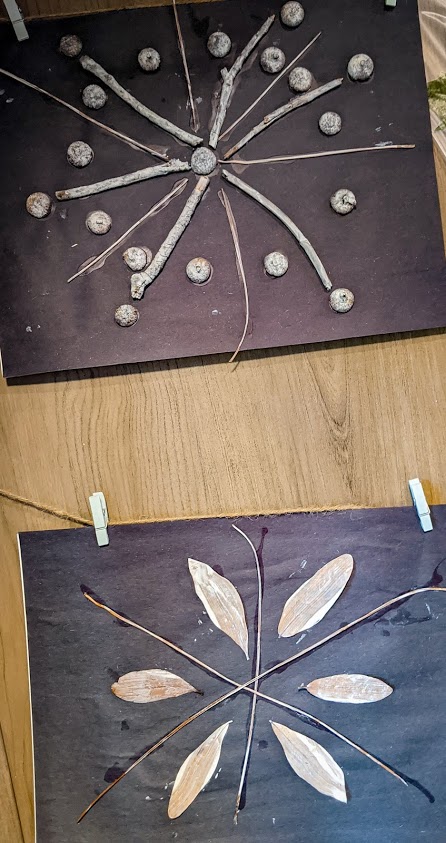
Taking STEAM learning outdoors
There you have it! Five nature-inspired outdoor STEAM activities that harness the power of education. Taking STEAM learning outside is not only an easy way to spend more time in nature, it also allows your children another way to see how interconnected the STEAM subjects are in their lives. And since this is a fundamental principle guiding STEAM learning, it makes absolute sense to combine the two.
Rosealind Franklin – a British biophysicist whose important contributions to the understanding of the molecular structures of DNA helped later scientists understand how genes are passed from parents to children – said it best:
Science and everyday life cannot and should not be separated.”
Which aspect of STEAM is your favorite?
Which of these outdoor STEAM activities
will you try with your kids?
The post Nature-Inspired Outdoor STEAM Activities for Kids appeared first on RUN WILD MY CHILD.
